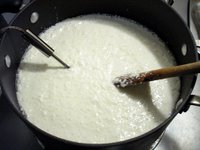 So I suppose it was inevitable that at some point, we would want to start making our own cheese. Fresh cheese, everyone tells us, is really easy -- no fuss and tastes great. Okay, then.
So I suppose it was inevitable that at some point, we would want to start making our own cheese. Fresh cheese, everyone tells us, is really easy -- no fuss and tastes great. Okay, then.We're starting off nice and easy with homemade whole milk ricotta. I guess ricotta was once the "leftover" cheese, as in whatever whey was left over from the process of cheesemaking you could recook (thus the name ricotta) and dredge out the last milk proteins so as not to waste a bit of it. This sounds suspiciously like Milk Protein Concentrate, which is that stuff you find in Kraft. I'm not so keen on that. But whole milk ricotta sounds yummy.
So we bought a half gallon of milk and even traispsed off to San Francisco Brewcraft to purchase some citric acid powder. I subsequently found out you could make ricotta with vinegar instead, but hey, there's always time for that later.
 I'll let you read Eric's account of our adventures at SF Brew -- which spurred on a whole other new obsession in the "make your own food" category. Between the cheese obsession, bake -your-own-bread, make-your-own-yogurt, and talk of laying down preserves in the spring to avoid the high fructose corn syrup we are fast becoming ready to move to Mendocino and start a commune.
I'll let you read Eric's account of our adventures at SF Brew -- which spurred on a whole other new obsession in the "make your own food" category. Between the cheese obsession, bake -your-own-bread, make-your-own-yogurt, and talk of laying down preserves in the spring to avoid the high fructose corn syrup we are fast becoming ready to move to Mendocino and start a commune.Anyway. Before that though, we're making ricotta.

We poured a half gallon of cold milk into a little stockpot, added a teaspoon of salt and a half teaspoon of citric acid. Then we dunked in our trusty Polder thermometer, set it for 185F and started heating the milk.
At first the milk looked only mildly curdled. A little bit of lumpiness formed on the top, but seemed more like skin than anything else. I stirred it gently as instructed (You don't want to break up the curds too much as they form apparently.)
As it got warmer I wasn't seeing much happen. "It's not working..." I whined. "It's not working."
I kept remembering all the stories I'd heard about everything that can go wrong with cheese.

Then, at around 170F suddenly, magic began to happen. "Curds, ahoy!"
Fast and furious, the process began to take shape, and suddenly, there was a really clear floater of cheese, real cheese, on top. About two inches thick, as promised. There was actual whey, or as I was thinking of it, "used cheese juice" separated from the coagulated cheese.
Marvelous!
 We turned off the heat and covered it with a cloth to um.. let the curds rest. Let me tell you, it ain't easy to keep yourself from poking at the curds with unreasonable glee.
We turned off the heat and covered it with a cloth to um.. let the curds rest. Let me tell you, it ain't easy to keep yourself from poking at the curds with unreasonable glee.The kind of icky looking greenish whey that's left over, according to Richard Fankhauser's informative and totally addictive Cheese Page, is mainly water and riboflavin.
 In the morning, we scooped (gently, gently!) the curds out of the liquid and placed them (gently, gently) in a strainer lined with --um -- a clean dishtowel. The ricotta drained quite quickly actually, and since we were planning to use this batch for ricotta gnocchi, we let it get pretty dry and grainy.
In the morning, we scooped (gently, gently!) the curds out of the liquid and placed them (gently, gently) in a strainer lined with --um -- a clean dishtowel. The ricotta drained quite quickly actually, and since we were planning to use this batch for ricotta gnocchi, we let it get pretty dry and grainy.Not that this was something we had ever made before, but it sounded good.
Interestingly enough, on Saturday morning I went by the Cowgirl Creamery at the Ferry building, on a completely unrelated Mimolette mission. They happened to have some REAL ricotta, which had a lovely golden straw color and tasted (gently) like butter.
 Not that ours is bad, you understand. But as with all things, it'sall about the ingredients. Okay, so for this first time, we started with store-bought milk (organic, but store-bought)
Not that ours is bad, you understand. But as with all things, it'sall about the ingredients. Okay, so for this first time, we started with store-bought milk (organic, but store-bought)As an aside, I will also mention the utterly creamy and throroughly decadent miticrema, a Spanish sheep's milk cheese from the Murcia region that they're carrying at Cowgirl now.
Ah well, anyhow, ricotta today, Camembert tomorrow! Whee!!

No comments:
Post a Comment